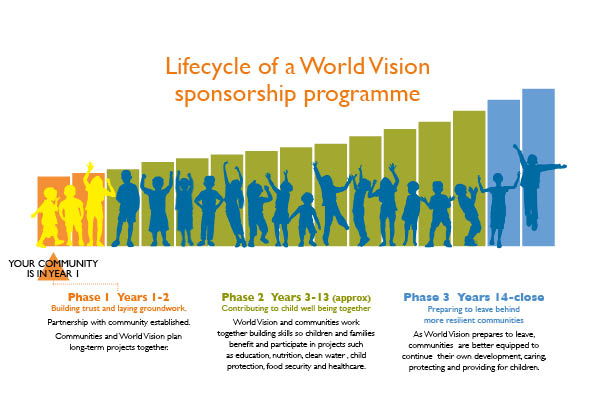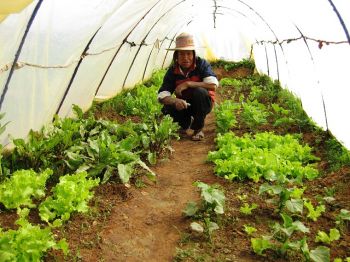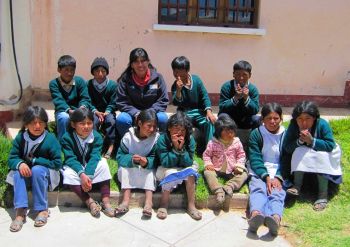What is an ADP?
You might know that your sponsored child lives in an ADP, but do you know what an Area Development Programme actually is? Our Sponsor Visit Coordinator, Reka, recently visited Bolivia and tried to dig a little deeper into what your support for an ADP actually means.

By Reka Gencsi, Sponsor Visits Coordinator, World Vision UK
The night before my flight, I didn’t get much sleep at all, I was just too excited! I have worked for World Vision for four years and in that time, I organised over 200 field visits but I have not had the chance to go on one myself until now.
I knew a lot about the way we work from our publications and all the meetings and presentations I have attended but I was dying to get on the plane and see it all for myself. I could not wait to finally visit ‘our communities’ we talk so much about.
As I was planning my trip to Bolivia, I discovered it is the poorest country in Latin America. About 60 percent of the population live below the poverty line. Child malnutrition is a real problem, indigenous groups have limited access to healthcare and many Bolivian families do not have adequate sanitation.
Improving the lives of the world’s poorest children
My aim for this trip was to find out how World Vision addresses the problems Bolivians face and whether we make a real, lasting difference in the lives of children. I had two weeks to carry out my ‘investigation’.
World Vision programmes tend to last for about 15 years and during that time the community goes through three phases.

1. Before the programme kicks off, we spend a couple of years in partnership with the community to assess their needs as well as build trust and relationships with the leaders of the community.
2. Our projects then move into the much longer implementation phase. Depending on the context, a number of different activities are put in place such as food security and nutrition, health and sanitation, education and child protection.
3. The last phase of the life cycle we call transition. By this phase, the community would have become self-sufficient so our time in the community draws to a close which gives us the opportunity to move onto another area depending on where the need is greatest.
What I really like about our development model is that it is focused on the needs of the selected area and it is the people who live in the community who own the development process.
The other aspect I really appreciate is that we are there for the long term which gives us a chance to effect lasting changes. World Vision comes alongside the community to provide financial assistance, training and encouragement in order to provide life in all its fullness to the children of the most vulnerable parts of the world.
Each ADP can look really different depending on the context and the need but here is an example from Bolivia:
Farming, food security and nutrition

The weather conditions are so extreme and the terrain so harsh that the soil barely produces anything.
Child malnutrition rates remain high throughout the country. The World Food Program estimates that about a quarter of Bolivian children under the age of five suffer from stunting as a result of malnutruition.
The solution to this problem is two-fold:
Firstly, a number of farmers in the community have been selected to take part in a micro-irrigation project.
These families up in the mountains own a plot of land that is located in a somewhat sheltered area where the earth is conducive to agricultural production. It is the farmers’ responsibility to cultivate the land but World Vision supports them in their hard work by providing tools, seeds and an irrigation system that enables them to have a fruitful harvest.
The other initiative that is used in the villages is the provision of micro-tunnels for household agricultural production.

The tunnel keeps the plants sheltered from the strong rays of the sun and torrential rains during the rainy season and keeps them warm in the cold nights.
The owners of these tunnels enthusiastically showed me around and told me about the progress they are making. I found it so inspiring to see that they were really proud of the work of their hand.
As a result of the project, they have got enough nutritious food to give to their own children and those in their neighbourhood.
While the men were competing about whose vegetables are growing greener and stronger, the women all gathered in the centre of their community to show off their cooking skills.
They split into groups and were preparing nutritious dishes they learnt how to make for their families. They made soup with quinoa, a nutritious Andean grain, meat with rice and potatoes and plenty of vegetables they had grown in their greenhouses. I loved watching the children enjoy their yummy lunch.
Education
I
World Vision amongst many other organisations has built a number of pre-schools in the communities. I visited one of them that totally blew me away.
The kids at the pre-school were healthy and happy and they are privileged to have all the modern equipment provided for them.
They have lovely, colourful classrooms that are nicely decorated. There are a lot of toys and equipment for them to learn to count, read and write on. They get a tasty, nutritious meal at lunch time that the teaching assistants lovingly prepare for them. In the breaks, they can run around and have fun in the play ground that has slides, trampolines, doll houses and a lot more for them to enjoy.
Community campaigning for better public services

This project is implemented in partnership with the council, community volunteers and World Vision. It has a lot of different groups of people involved in it. There are children and young people, women and men.
All of these different groups gather on a regular basis and are educated about their rights and responsibilities
One of the schools I visited were holding a youth network meeting when we got there and we had a bit of an insight into what they do, knowing their rights and what they can expect the state to provide for them.
The kids were really engaged and enthusiastically told us about how they are putting pressure on their government to provide better quality public services.
The unsung heroes of World Vision
I have seen with my own eyes how the work of World Vision improves the lives of those living in our communities. But who is it that makes it all happen? During my time in Bolivia, I spent a number of days with our wonderful ‘field staff’ who work in our ADPs.
I always knew they were hardworking and committed but there was one night that meant an awful lot to me as it gave me a glimpse into the reality of their day to day life.
I spent a night in one of the communities where our ADP office is located, about three hours away for the nearest town. There are eight people who work in this office; some in sponsorship and others have their expertise in water and sanitation, health and nutrition and advocacy. We were sitting around the table, enjoying a lovely meal a member of staff prepared for us and we were chatting about work and life.
M
They wake up unbelievably early on Monday morning, pack their belongings and leave their families to travel to the office for the week.
Luis has two children and his wife is 6-months-pregnant. Rene has three children at home. Lourdes has a 2-year-old boy at home who is looked after by his grandma. Alina has two daughters.
They explained to me that the best thing to do is to sneak out of the house really early while the children are still asleep as it doesn’t hurt quite as much and the kids don’t get upset at the sight of mummy or daddy leaving the house.
During the week, they try to keep in regular contact on the phone but it is just not the same as being together. Being away gets really hard when the kids are sick or it is their birthday or they perform at school and the proud parents can’t be there to support them.
I asked about what life is like in the ADP. They would never complain but they admitted that it’s not easy. The sponsorship facilitators wake up at 5 am and make their way to the different villages on bikes, motorbikes and sometimes on foot which can take up to three hours.
They try to reach families before the kids go to school and the parents to the fields in order to deliver letters and parcels from sponsors. If they don’t catch the families at home, they go looking for them until they find them.
They often work 12-14-hour-days. I didn’t get why anyone would want to work and live like that so I asked.
They told me they do it because they are really passionate about World Vision’s amazing mission to provide life in all its fullness for the poorest children around the globe.
They leave their families behind for the week, wake up early and walk up and down the mountains because they love the children and want to see the smile on their faces when they receive a letter or present from their sponsor and that moment makes up for all the hardship and pain.
Their stories deeply humbled and touched me and made me feel really privileged once again to be a part of what World Vision is all about.
If you want to know more about our ADPs or Reka's trip to Bolivia, you can see more photos and asking any questions you have on our Facebook page right now.
